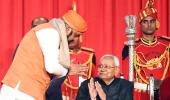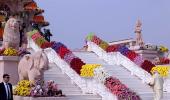Will January 22 mark a point of no return for our Constitutional secularism? asks Shekhar Gupta.

It would be delusional to argue that January 22 won't henceforth be among the most important dates in our national calendar.
Invention of a big new festival for the world's oldest religion is quite an achievement for Narendra Modi. Some political questions that follow, however, deserve a debate.
Will January 22 mark a point of no return for our Constitutional secularism?
Is a counter to the ideological proposition now carved in the Ayodhya rock by the Modi-Shah Bharatiya Janata Party possible? Do Modi's challengers have a future?
If the answer to all of these is one of resignation, then we had better close the debate now. But we need not do so.
Because that would be making the ridiculous presumption that henceforth, there will be no competitive politics in India.
Politics never stops in any society. If it didn't even stop in Ayodhya's Ram Rajya, it won't in a 21st-century democracy, however flawed it might seem from where you stand.
The most unexpected outcome of the Ayodhya event is how easily the many challengers to the Modi government and the BJP's ideology have conceded defeat.
Many fear the Republic is dead, or at least that the Republic they grew up with, built by the founders they so adore, no longer exists.
That may partly be true. But it is in the nature of democracies that elected leaders can change their character and direction.
If you disagree, it doesn't mean it's dead. This Republic has been tempered through the agnipariksha of Indira Gandhi's Emergency.
It just so happened that the political forces she locked up in her jails for up to 21 months subsequently showed the steel to redeem the Republic.
It is their children and legatees who are now modifying and redefining some of its foundational principles. They can be challenged, just as Mrs Gandhi was in the 1970s.
It is just that the challengers will need more than just righteous outrage. They can learn from the BJP's fight back.
It demonstrates how a dominant political power can be decimated, and how another can rise from nowhere.
Check out how the numbers changed for the BJP. The party was formed in April 1980 just after the January elections brought Mrs Gandhi back to power.
It was the new name for the old Jana Sangh and fully represented the ideology of the RSS.
In its first Lok Sabha outing in 1984, it won all of two seats. The next time, in 1989, it reached 85, then 120 (1991), 161 (1996), 182 (1998) and 182 again in 1999.
The last two results gave it six years in power under Atal Bihari Vajpayee.
The remarkable fact that stood out in these years was how flexible it was with its core ideology.
The founders of the new party had the smarts to balance power with ideology. For the big philosophical issues so close to your heart, the time will come.
It is possible that your generation won't be able to redeem that tryst with destiny (sorry Nehru fans), but your children will.
To understand how patient and wily you need to be, again learn from the BJP.
In 1989, it won 85 seats and could have asked for a share in a national coalition.
But it did not. Instead it offered support to V P Singh's Janata Dal from outside, alongside its bitterest ideological enemy (it's deliberate that we prefer 'enemy' to 'rival') the Left Front.
There was no shame in joining hands with the enemy's enemy. There was a purpose.
First, to keep the Congress out of power to weaken it; and because an unstable third front coalition would further convince Indians of the need to have a national party in control.
And it did not compulsorily have to be the Congress. They had a choice now.
And second, to give itself time to build the temple campaign. The BJP lost power in 2004 for a decade, but never fell below the three figure mark.
Six years in power and credible governance had built its base. By the end of this vanvas from power, it had also built new talent and leadership, personified by Narendra Modi.

How did Mr Modi rise and become a colossus in national politics to rival Indira Gandhi?
He was a mostly unknown RSS apparatchik assigned to Gujarat in the mid-1990s.
He did not rise to the top because of seniority, dynastic entitlement, or some high command diktat.
He fought within the BJP, the closest to a 'primary' process seen in Indian politics.
That's how he defeated so many seniors, former and serving party presidents and other national stalwarts.
The party -- and its rank and file -- discarded the leadership that had lost 2004 and 2009. Compare this with the approach of the BJP's rivals since 2014.
Revolutions do not come overnight in stable, Constitutional democracies. They sometimes transcend generations.
Between the two-seat disaster of 1984 and the majority of 2014, it took the BJP three decades of hard work, endurance and some sacrifices.
Its leaders did not give up when their party had ceased to exist and Mrs Gandhi returned with a massive majority (353 seats out of 529 polled).
If they wanted to say it was the end of the Republic, they'd be even more justified than those Modi critics heartbroken after January 22.
Especially as in January 1980, they would have thought they had just rescued it from the Emergency and the voters squandered it so quickly.
And if the people of India were willing to forgive Mrs Gandhi and vote her back into power so soon, did they really deserve this democracy?
To say that the Republic is dead, and so is its liberalism, is defeatism in anger.
It sounds like that furious parent in a 1970s movie telling their wayward child: 'Tum mere liye mar chuke ho (you are dead as far as I am concerned).'
Democratic politics is always a battle of ideas, ideologies. Constitutional republics do not die, political leaders, parties, ideas do.
Where did the libertarian idea of the Swatantra Party vaporise, for example?
In the 1967 election, its tally of 44 was second highest after Indira Gandhi's Congress, ahead of the Jana Sangh's 35.

The next level of defeatism manifests in the fears that Mr Modi now has the power to abrogate this Constitution, write a new one, change India into a presidential system and declare himself President for life, this will be the last election and so on.
However, he will do no such thing. He draws all his power he needs from the same Constitution, Parliament and elections.
Why would he change the 'system' if it works so brilliantly for him?
It is within the same system, Constitution and politics that his rivals will need to find the political, intellectual and moral wherewithal to defeat him.
And rectify the direction of the Republic if they do not like the course on which Mr Modi has now set it.
By special arrangement with The Print
Feature Presentation: Aslam Hunani/Rediff.com











